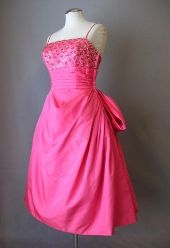
It's 1935 and clothes are slim and body conscious. Bias cuts reign, which means your dress clings to every curve, bump, and ripple. What's a gal to do?

You wear a girdle, of course! One piece girdles or corsets with attached bras were in commercial production with the aid of a new latex yarn called Lastex, which slimmed and supported the figure without the use of heavy boning.

Low cut backs in dresses called for ingenuity in the design of corsets. This one, without garters, was advertised as being wearable under evening gowns
and swimsuits.

Here we see another low backed design and the attached ribbon garters used to hold up one's stockings.

In 1935, Warner's introduced better fit with 4 different cup sizes - A, B, C, and D.

Many evening gowns of the 1930s were daringly low cut, sometimes backless, with tiny straps. Now, what's a gal to do?

This ad for lingerie by Maguerite Sacrez solves the puzzle. This long line girdle extends up to just below the breasts. Also shown in the ad is a separate bra that could be worn with the girdle, if desired.
 It's 1935 and clothes are slim and body conscious. Bias cuts reign, which means your dress clings to every curve, bump, and ripple. What's a gal to do?
It's 1935 and clothes are slim and body conscious. Bias cuts reign, which means your dress clings to every curve, bump, and ripple. What's a gal to do? You wear a girdle, of course! One piece girdles or corsets with attached bras were in commercial production with the aid of a new latex yarn called Lastex, which slimmed and supported the figure without the use of heavy boning.
You wear a girdle, of course! One piece girdles or corsets with attached bras were in commercial production with the aid of a new latex yarn called Lastex, which slimmed and supported the figure without the use of heavy boning. Low cut backs in dresses called for ingenuity in the design of corsets. This one, without garters, was advertised as being wearable under evening gowns and swimsuits.
Low cut backs in dresses called for ingenuity in the design of corsets. This one, without garters, was advertised as being wearable under evening gowns and swimsuits. Here we see another low backed design and the attached ribbon garters used to hold up one's stockings.
Here we see another low backed design and the attached ribbon garters used to hold up one's stockings. Many evening gowns of the 1930s were daringly low cut, sometimes backless, with tiny straps. Now, what's a gal to do?
Many evening gowns of the 1930s were daringly low cut, sometimes backless, with tiny straps. Now, what's a gal to do? This ad for lingerie by Maguerite Sacrez solves the puzzle. This long line girdle extends up to just below the breasts. Also shown in the ad is a separate bra that could be worn with the girdle, if desired.
This ad for lingerie by Maguerite Sacrez solves the puzzle. This long line girdle extends up to just below the breasts. Also shown in the ad is a separate bra that could be worn with the girdle, if desired.















